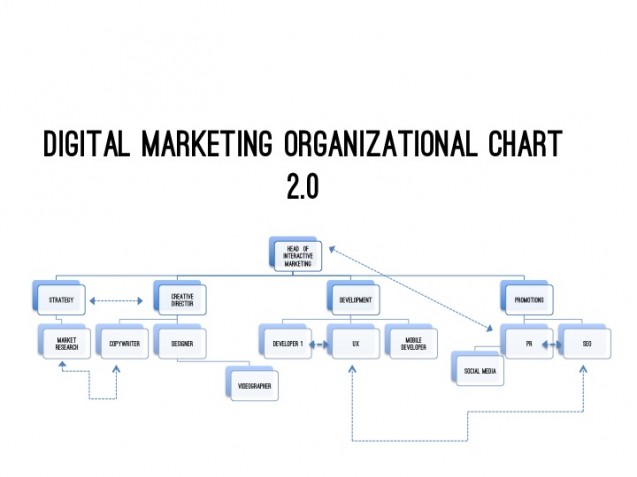As large organizations and agencies continue to broaden their digital capabilities, they can count on having to deal with multiple challenges. Why? Digital marketing has become more complex in the past few years. Content marketing requires interaction between SEO, designers, and copyeditors. Social media specialists shuffle between the PR department and the marketing department. In the end, managing a united front can be a challenge. This kind of growth often means organizations struggle with the ability to create one happy, process-driven digital marketing family.
I have worked at three different organizations – a tourist bureau, higher education institution, and today the digital marketing agency iAcquire. All vastly different types of organizations, yet somehow we all quarreled with ubiquitous ownership of digital marketing . Shouldn’t we all just get along? Yes, but that’s not an easy task. Here are some tips for solidifying the business process inside your marketing family:
Defining Who Fits Where
Before you grow a team, you must create an organizational blueprint. Simple and obvious as it may sound, make this blueprint deep: include not only names and job functions, but also the work styles and strengths/weaknesses of each player. Conflicting personalities and work styles can inhibit collaboration and functionality. Do not put two lions together, but by the same token, do not put two lambs together, either: in order to get team members on-board, they need to feel they can lead AND take direction at different points in the process.

[Here’s an example of a what a modern-day marketing department could look like… Open up a Microsoft Powerpoint Presentation slide, and play around with functions and reporting structure.]
Make the development of this blueprint a group exercise: collaborate and converse on functions, roles, and reporting structure. By avoiding a top-town order, you can reassure workers that every thing they bring to the table is a crucial part of the pie. Make sure to have an “all hands on deck” meeting to share the final layout, demonstrating that cross-functioning groups can develop valuable solutions.
Organizational charts can also be fluid documents based on each marketing campaign. Each creative brief could include the desired “layout” of your team. Include hard lines (direct reports) and dotted lines (mentor/working relationships). In its best form, this organizational chart should serve as a supplement to a project outline or creative brief so that all players know their roles and responsibilities.
Define Shared Organizational Goals
The next step is defining shared organizational goals. Is your goal to convert new customers into clients? Is it to drive awareness and traffic? Is your goal tied to a specific marketing campaign or product launch?
Your goals need to include the defined players, key performance indicators (KPIs), and creative tactics to become a reality. If each project has shared (not exclusive) KPIs, each one of your team members will work more uniformly and towards a common goal. After you collect your assets and assign roles, define how you’re going to measure the success of your campaign efforts. Select a series of three to four shared KPIs based on the entire team’s overarching marketing goal. These should typically include conversion, referral, and share of voice-type metrics.
Assign a Project Leader
Pick a project leader and divide up roles. For example, iAcquire’s marketing team holds status meetings where we brainstorm new campaign ideas, review current projects, and make sure to delegate a project lead for each of the campaigns.
You can also invest the money into a dedicated project manager who can see the plan through with a clear head. This role should drive timelines, budget, deliverables, and personnel. The project leader should use live project management tools like Trello to manage all of the moving parts. He or she should also regularly touch base with each of the team members to make sure project deliverables are on time.
Setting Up Building Blocks for Collaboration
While you may be able to successfully create organizational chart, set up the right documentation, establish shared KPIs, the most important thing you need to do is figure out how to get your team to work well in collaboration with each other. What are characteristics for a collaborative team? Huffington Post recently published an article that highlights the top traits:
A Shared Vision
- Everybody is working toward the same goals
- Team members are clear on how to work together and how to accomplish tasks
- Everyone understands both team and individual performance goals and knows what is expected of them
A Democratic Environment
- Each team member carries his or her own weight and respects the team processes and other members
- No individual members are more important than the team
- The leadership of the team shifts from time to time, as appropriate, to drive results
- The team makes decisions when there is natural agreement, in the cases where agreement is elusive, a decision is made by the team lead or executive sponsor, after which little second-guessing occurs
Clear Communication
- People have solid and deep trust in each other and in the team’s purpose — they feel free to express feelings and ideas
- The team engages in extensive discussion, and everyone gets a chance to contribute
The Bottom Line
A lack of these traits can lead to incoherence, and can even cause a shift in the way consumers view your brand. More so, a lack of internal communication can cause disjointed brand messaging (imagine a company where the social media presence is stiff and formal and a campaign is fun and free: because these team members are not communicating, the brand isn’t communicating as a cohesive unit). Within this process — as roles, resources, and shared goals are created — the different parts of a marketing team can work to mix efforts, figuring out what works and what needs to be worked on. In doing this you can avoid conflicting representation of your brand and, in the process, create a happy workplace.
Image via iStock Photo.





